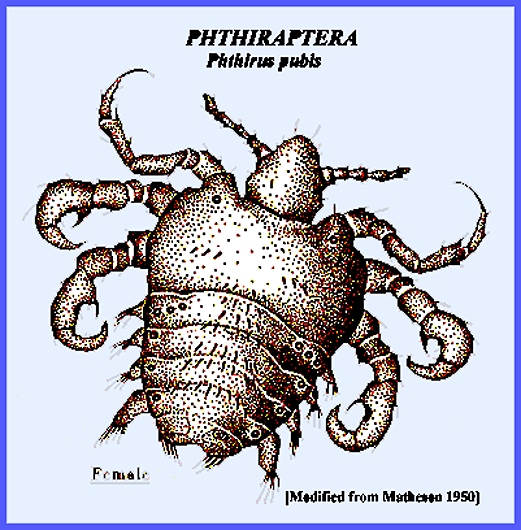File: <phthirapterakey.htm> <Medical
Index> <General Index> Site Description Glossary <Navigate to Home>
|
Arthropoda: Insecta PHTHIRAPTERA
KEY ("Anoplura"
= Sucking Lice) (Contact)
Please CLICK on underlined links to view images or to navigate
within the key: To Search
for Subject Matter use Ctrl/F [See: Phthiraptera Details] Phthiraptera (=
Anoplura) are the sucking or true lice that are ectoparasitic on mammals
(primates, ungulates, canines and rodents).
Most important on humans are the head louse, body louse and crab
louse. The evolution of these lice
with their hosts is closely paralleled.
They are small wingless insects that live entirely as ectoparasites on
mammals and birds and in the clothing of humans. Their mouthparts are adapted
for piercing the skin and sucking the blood of their hosts. The eyes are
poorly developed or absent, and there are no ocelli. Antennae are very short
with 3-5 joints. The legs are very
short and the single-jointed tarsus carries a large curved claw that is well
adapted for clinging to the host. The
thoracic segments are fused, and a flattened abdomen of nine segments has
large pleural areas allowing the body to swell on feeding. There is no metamorphosis. . The mouthparts are adapted for
piercing and sucking blood. The
biting lice, Mallophaga, that are not of great medical importance to humans,
have chewing mouthparts that feed on scales, feathers, and skin waste
(Matheson 1950). Sucking lice are all
permanent ectoparasites of mammals.
They have highly modified mouthparts, which when at
rest are pulled back within a diverticulum that opens into the lower part of
the pharynx at its anterior end. The
thoracic segments are fused save for the genus Haematomysus. The
tarsi have only one segment and end in a single claw that is adapted for
grasping and clinging to hair. Eggs
are attached to the host's hair (Fig. 4).
[Also see: Phthiraptera Details] Phthiraptera is a small
group of insects with about 230 species.
They are all bloodsucking ectoparasites of mammals, and among the four
families only the Pediculidae have species that are of medical importance to
humans. The following key
distinguishes these families:
= = = = = = = = = = = = = = =
= = = = Key References: <medvet.ref.htm> <Hexapoda> Burgess, I. F. 1998.
Head lice: developing a practical approach. The Practitioner 242:
126-69. Burgess, I. F. 2004.
Lice and their control. Ann.
Rev. Ent. 49: 457-81. Burgess, I. F., C. M. Brown & P. N. Lee. 2005.
Treatment of head louse infestation with 4% dimeticone lotion: randomised controlled equivalence trial. BMJ 330: 1423-25. Buxton, P. A. 1948.
The Louse: An Account of the
Lice which Infest Man, Their Medical Importance & Control, 2nd ed.,
Edward Arnold, London. Chetwyn, K. N.
1996. An overview of mass
disinfestation procedures as a means to prevent epidemic typhus. IN: Proc. 2nd Intern. Conf. on Insect Pests in the Urban Environment. ICIPUE:
pp 421-416. Matheson, R. 1950. Medical Entomology. Comstock Publ. Co, Inc. 610 p. Service, M. 2008.
Medical Entomology For Students.
Cambridge Univ. Press. 289 p Meinking, T., C. N. Burkhart & C. G. Burkhart. 1999.
Ectoparasitic diseases in dermatology: reassessment of scabies and pediculosis. Adv. Dermatology 15: 77-108. Nuttall, G. H. G. 1917.
The biology of Pediculus humanus. Parasitology 10: 80-185. Orkin, M. & H. I.
Maibach (eds.). 1985. Cutaneous Infestations & Insect
Bites. Marcel Dekker, NY., Chapt.
19-26. Service, M. W.
(ed.). 2001. The Encyclopedia of Arthropod-transmitted
Infections of Man & Domesticated Animals. CABI: pp. 70-3, 170-4, 295-9. Zinsser, H. 1935.
Rats, lice and history. Boston Globe. Zinsser, H. 1937. The
rickettsia diseases: varieties,
epidemiology and geographical distribution.
Amer. J. Hyg. 25:
430-63. |
